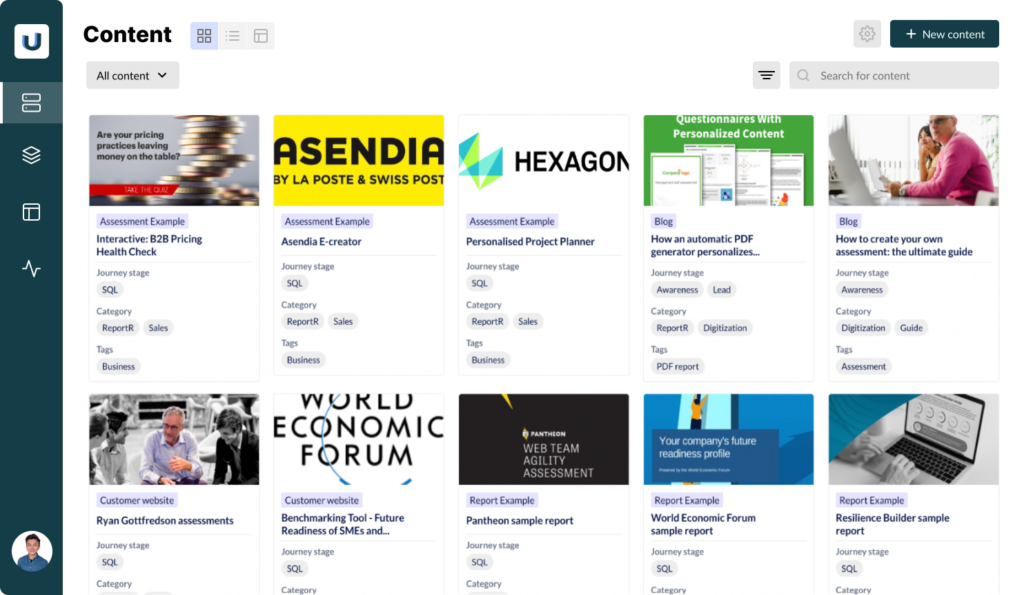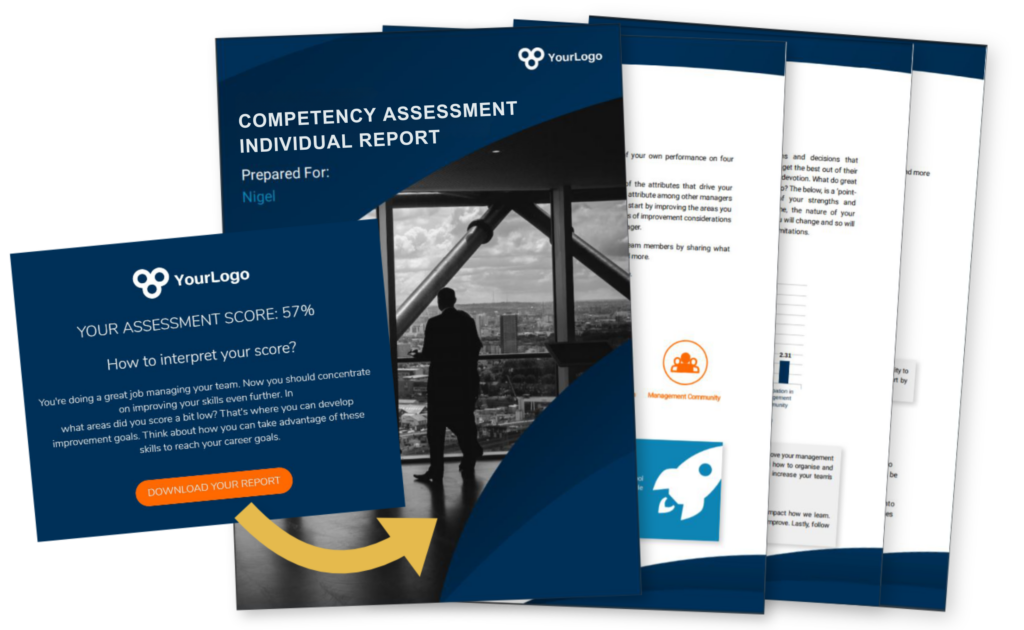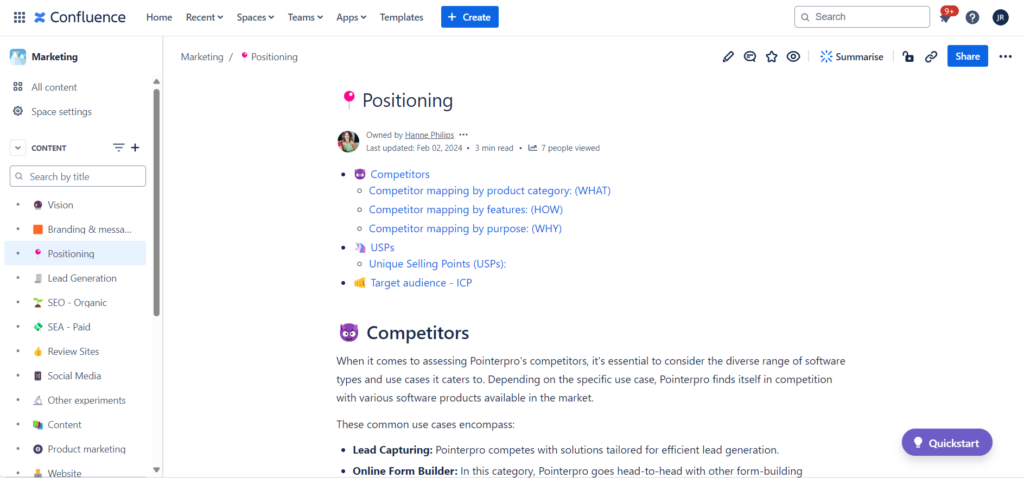Last year, our sales team asked our Product Marketer Chris to build a spreadsheet overview of all the marketing content we’ve produced over the years. The goal? Help customers and future customers with useful resources. Instead, Chris built a full-blown application, allowing our colleagues to find relevant content for anyone in a few clicks – no matter what their industry, specialization, or challenge.
Today’s business landscape requires this type of agility and taste for innovation. Typically, that’s where external consultants come in. But maybe you have someone like Chris in your company too? An intrapreneur, or “internal consultant,” so to speak. In this article:

How to find intrapreneurs: Recognize the competence centers in your organization
In almost every areas of business, it’s a solid strategy to start with identifying a problem and then going after a solution. When looking for intrapreneurs, it’s useful to flip that logic around. Why? Otherwise you risk overlooking talents and skills that can be valuable in the future – simply because they don’t happen to address the problem in front of you right now.
So, the first step is to recognize the unique strengths and capabilities that exist across your various departments and divisions. Don’t view these as siloed units, consider them as “competence centers” – specialized hubs of expertise that can benefit the entire organization. As a copywriter, I believe in the power of words. So, I would go as far as saying actually calling them “competence centers” is a smart thing to do. It will change people’s mindset for the better.
At Pointerpro we have diverse teams with specialized skills in different areas. Traditionally, they’d be called marketing, product development, customer service, and sales. By acknowledging the unique competencies of each department, I’m convinced our management is doing a great job at fostering a culture of internal collaboration and idea-sharing (and I’m not saying them, hoping they’ll read this).
So how do we learn from each other?
Here are a two examples:
- Our team of developers is incredibly good at agile working. As a marketing department, we learn from them how to organize our projects more efficiently.
- Our sales team are solution experts. They’re great at catching on when potential customers discuss their challenges with them. With these insights they inspire our product specialists to design new functionalities.
By recognizing the competence centers within your organization, you can start to identify the intrapreneurs – those employees who possess the skills, creativity, and drive to innovate and solve problems, even if they’re not in a traditional “innovation” role.
Strategies to boost internal consulting and intrapreneurship
Now that you’ve identified and labeled “competence centers” in your company, it’s time to put them to work. Here are a few strategies to empower your intrapreneurs:
1. Organize lunch and learn sessions
One effective way to encourage cross-departmental collaboration and knowledge-sharing is through regular “lunch and learn” sessions. These informal gatherings provide a platform for employees to share their expertise, showcase their skills, and inspire their colleagues.
The goal is to rotate the responsibility of organizing these sessions, giving different departments the opportunity to lead a workshop or presentation on a topic that would benefit the wider team.
The key advantages? It breaks down silos, alllows employees to step outside their comfort zones and it gives people the chance to showcase talents that have gone unrecognized, so far. And of course, if done wel,l it can be a proper training initiative that gradually upskills your employees.
2. Allocate innovation time off (ITO)
Another powerful strategy to awaken the entrepreneurial spirit within your organization is to provide dedicated “Innovation Time Off” (ITO) for your employees.
By allocating a reasonable portion of their work time for passion projects or innovative ideas unrelated to their daily tasks, you’re empowering them to explore their creativity and develop new solutions. Because, face it: Your employees aren’t being productive on their traditional tasks 100% of the time anyway. They’re human.
The ITO approach transforms otherwise wasted time into productive use, often revealing hidden talents – even to the employees themselves. Moreover, it will inspire employees to think in function of the company’s mid- to long-term goals, beyond their traditional responsibilities.
ITO can also spark internal mobility. Who knows, maybe down the road your sales account executive actually turns out to be a great addition to your marketing team?
3. Launch internal consulting (or “internal innovation”) challenges
If your company is facing specific, short-term business challenges or problems, why not create cross-departmental task forces to tackle them? By assembling teams with diverse skill sets and perspectives, you can tap into the collective intelligence of your organization, and in the meantime, once again help your employees with their professional development.
As a matter of fact, the reason I am a marketing copywriter today may well be thanks to an internal consulting challenge one of my first employers organized.
We were a start-up with no marketing department. My job title was “R&D engineer.” The challenge for everyone was to come up with a new brand name, as we were repositioning our e-commerce website. Our core had always been rebates and cashback (hence the initial name “Planet Rebates”), and we repositioned ourselves as more of an international social shopping platform (long live the 2010s). My team and I came up with the name and slogan (the name had to work for about six languages).

Ok, sure it sounds a lot like “Zalando.” I know. We may have reinvented the wheel there, just a bit. But my point is it revealed to me that one day I could maybe be a creative copywriter. And here we are.
Internal innovation challenges not only help to solve pressing issues, but they also provide a platform for employees to collaborate more closely with colleagues and nurture their problem-solving skills.
Don’t forget about rewards. Rewarding the teams for their efforts will further reinforce the value of intrapreneurship within your company. I received an iPad2, back in the day. It was a big deal to me.
4. Conduct competency assessments
If you want to make talent development in your company more tangible, and truly map out the untapped potential within your organization, just make assessments part of your culture.
With comprehensive competency assessments you map out the skills and capabilities of your employees. You’ll identify areas of strength, as well as opportunities for growth and cross-training.
Now, the key is to avoid employees feel as though they’re constantly being evaluated. That isn’t the point indeed. That’s why at Pointerpro we find it so important to couple assessments with automated PDF reports. The point is to give something to your employees that helps them.

Anyway, this data-driven approach can help you make some important, informed decisions:
- Where to allocate internal resources
- How leverage the talents of your internal teams
- Where to seek external expertise (external consultants)
How to create a culture of internal consulting and intrapreneurship
Implementing these initiatives is a hands-on strategy to implementing internal consulting. But culture eats initiatives for breakfast. You’ll need to cultivate a culture that embraces innovation, collaboration, and continuous learning.
Ironically – but when you think about it, quite logically – one of the most effective ways to turn your employees into internal consultants is to let them be joined by fractional, external consultants every once in a while.
Why? Because this way everyone gets to experience first-hand that your company is one that embraces new ideas, and out-of-the-box thinking that challenges the status quo. At Pointerpro, an HR consultant joined our office for one day per week during the course of last year, and our Slack hygiene has improved tremendously in the process. So have our habits around centralizing important guidelines, for which we rely on well-structured Confluence pages.
This document management system has allowed us to take internal knowledge retention to a new level at Pointerpro.
Kudos to another one of my marketing colleagues, Hanne, for bringing out the intrapreneur in herself and making so many of our Confluence pages ultra-clear and easy to browse through for everyone in the organization.

How to build automated survey reports with Pointerpro
Here’s a quick introduction on how Pointerpro works, brought to you by one of our product Experts, Chris.
This is what clients say about us:



Conclusion:
At Pointerpro, we’ve seen team members work and evolve across departments, and our teams are joined by consultants in the office every day. It’s a great mix we’d recommend anyone to implement sooner rather than later.
By breaking down silos, encouraging cross-pollination of ideas, and empowering your employees to take ownership of their own professional development, you can create an environment where intrapreneurship thrives. This, in turn, can lead to increased innovation, improved problem-solving, and accelerated growth for your organization.
If you want to start using assessments to gauge competencies, do gap analyses and measure your overall readiness levels for intrapreneurial programs, you’re already where you need to be.
Feel free to book a meeting with one of our solution experts.








